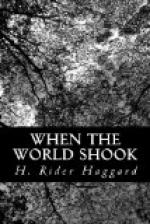Sure enough when we reached it there was Tommy with his black nose pressed against the lowest of the tiers that formed the base of the statue, and sniffing loudly. Also he was scratching in the dust as a dog does when he has winded a rabbit in a hole. So engrossed was he in this occupation that it was with difficulty that I coaxed him to leave the place.
I did not think much of the incident at that time, but afterwards it came back to me, and I determined to investigate those stones at the first opportunity.
Passing the wrecks of the machines, we emerged on to the causeway without accident. After we had rested and washed we set to work to draw our canoe with its precious burden of food right into the mouth of the cave, where we hid it as well as we could.
This done we went for a walk round the base of the peak. This proved to be a great deal larger than we had imagined, over two miles in circumference indeed. All about it was a belt of fertile land, as I suppose deposited there by the waters of the great lake and resulting from the decay of vegetation. Much of this belt was covered with ancient forest ending in mud flats that appeared to have been thrown up recently, perhaps at the time of the tidal wave which bore us to Orofena. On the higher part of the belt were many of the extraordinary crater-like holes that I have mentioned as being prevalent on the main island; indeed the place had all the appearance of having been subjected to a terrific and continuous bombardment.
When we had completed its circuit we set to work to climb the peak in order to explore the terraces of which I have spoken and the ruins which I had seen through my field-glasses. It was quite true; they were terraces cut with infinite labour out of the solid rock, and on them had once stood a city, now pounded into dust and fragments. We struggled over the broken blocks of stone to what we had taken for a temple, which stood near the lip of the crater, for without doubt this mound was an extinct volcano, or rather its crest. All we could make out when we arrived was that here had once stood some great building, for its courts could still be traced; also there lay about fragments of steps and pillars.
Apparently the latter had once been carved, but the passage of innumerable ages had obliterated the work and we could not turn these great blocks over to discover if any remained beneath. It was as though the god Thor had broken up the edifice with his hammer, or Jove had shattered it with his thunderbolts; nothing else would account for that utter wreck, except, as Bickley remarked significantly, the scientific use of high explosives.
Following the line of what seemed to have been a road, we came to the edge of the volcano and found, as we expected, the usual depression out of which fire and lava had once been cast, as from Hecla or Vesuvius. It was now a lake more than a quarter of a mile across. Indeed it had been thus in the ancient days when the buildings stood upon the terraces, for we saw the remains of steps leading down to the water. Perhaps it had served as the sacred lake of the temple.




